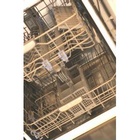Find out about cleaning washing machines of detergent, additives, and hard water buildup. Here are some tips for how to clean both front-loading and top-loading machines.
It may be surprising to some that a washing machine itself requires cleaning. However, laundry detergent and additives are not always completely rinsed away and hard water can leave deposits that may eventually damage your machine.
Front Loading Washing Machine

I have noticed though that a front loader gets dirty over time and can even start to stink rather badly if action is not taken. The top drawers where you place detergent and other additives can accumulate scum and a layer of hardened lint may cloud the transparent door. Humidity can develop into a black mold inside the rubber door seal and create a possible source of bad odors.
All of these problems are easily taken care of, even if you have been putting off cleaning your machine for a while.
Cleaning Washing Machine Front Loader
Step 1. Begin by removing the detergent and additive drawer. You may need to consult the owner’s manual to see how to do this correctly – don’t force it. This can either be washed in hot water in the sink or placed in the top rack of the dishwasher and washed there. You may need to use a toothbrush to get into the nooks and crannies.
Step 2. Using a warm, damp cleaning cloth, and possibly a little all-purpose spray-on cleaner, wipe out the cavity into which the drawer fits. You may need to use a toothbrush and warm water to get down into the crevices here.
Step 3. Once again, using a warm damp cloth, thoroughly wipe out the inside of the rubber door seal. I advise against using any harsh cleaning products in this area, as the rubber could be damaged. Wipe all around the door itself as well, both inside and out.
Step 4. Return the drawer to its place and fill the appropriate partition with a cup of bleach. Run the empty washing machine on the hottest cycle. The bleach will flush through the system and eliminate all bad odors. I usually run a load of white towels after doing this, just to be sure that all traces of bleach have been eliminated from the system. However, this is probably not necessary. Learn more about cleaning with bleach.
Step 5. Wipe the top and sides of your washing machine occasionally with a soft, damp cloth. Keeping it dust and debris free, as well as dry, will prolong the finish on these parts.
Another Job for a Steam Cleaner
You can use a home steam cleaner to keep your front loader sparkling clean. Once a week, I simply give the drawer, the door, and the seal a quick blast of steam and then wipe them clean with a microfiber cloth. This is enough to keep these parts permanently clean. However, the machine still requires a monthly empty run with hot water and bleach to keep odors at bay.
Cleaning Washing Machine Tip: It is a good idea to leave the door and the drawer of your front loader ajar when you’re not using the machine. This reduces humidity and odors from developing.
Top Loading Washing Machine
Although less likely to develop odors, a top-loading machine will still require regular cleaning to keep it in tip-top shape. Here’s a way to clean a washing machine with all-natural cleaning products.
Cleaning Washing Machine Top Loader
Step 1. Fill the empty machine on the hot water cycle until it is full. As it begins agitating add 2 cups of distilled vinegar. For extra cleaning power and deodorizing you can also add 1 cup of baking soda. Allow it to agitate for a minute and then stop the washing machine. Leave it to soak for 30 minutes or so with this cleaning solution, then turn it back on to run a complete cycle. Learn more about cleaning with vinegar.
Step 2. Immediately after it has emptied carefully wipe all surfaces of the interior of the washing machine with a damp cleaning cloth. You can use a little of your favorite cleaning solution (try water mixed with vinegar and a little dish detergent) to help with this. Be sure to clean up under the rim of the machine where scum tends to accumulate and don’t forget the underside of the lid.
Step 3. Wash all removable parts (many times the receptacles for additives lift out) with hot water, or just put them in the top rack of the dishwasher.
Step 4. Replace any parts, then wipe the top and sides of the machine with a damp soft cloth. It is also a good idea to move your washing machine every once in a while and clean the floor underneath. You may be surprised at what you find under there.
Cleaning Washing Machine Tip: Fabric softener contributes greatly to the accumulation of scum in a washing machine. Try replacing your commercial brand with this homemade fabric softener, made with vinegar and baking soda. Not only does this formula soften your clothes, but the vinegar also removes virtually all traces of detergent from your clothes and your machine, so things come out cleaner as well.
You Might Also Like . . .




